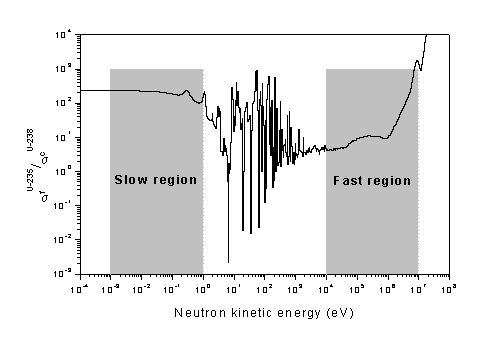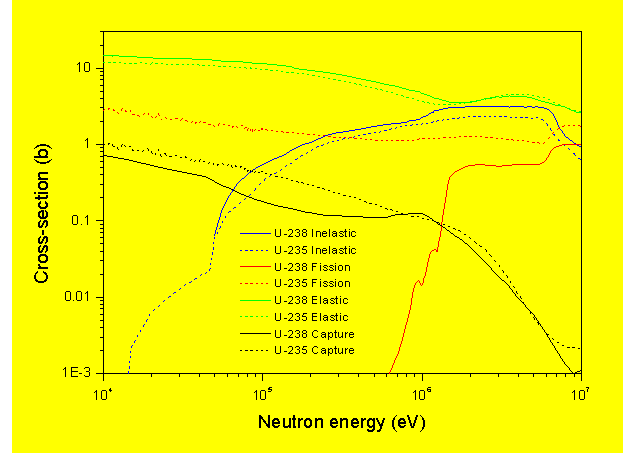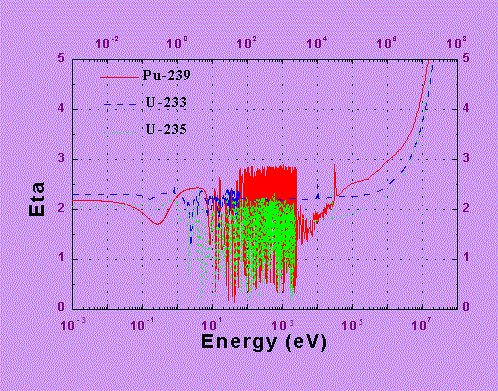The question is pertinent since the neutrons at birth in fission are very fast with an average kinetic energy of about 2 MeV, and the neutrons have to be slowed down artificially, to have a thermal reactor. The answer lies in the neutron-nuclear reaction properties. A reactor works mainly based on fission chain reaction. Assume that every fission gives one neutron to continue the chain, the excess if any being lost somehow. Let s denote probability of a neutron reaction with one nuclide, with a suffix indicating the reaction, and the superscript indicating the nuclide. Let us analyze sfU-235/scU-238 curve vs. energy given in Fig.1. For the fissions to be more than captures, NU-235 sfU-235/NU-238scU-238 must well exceed unity. N represents the isotopic concentration. In the case of natural uranium NU-235/NU-238 is about 0.7/99.3 (~0.00705) and so sfU-235/scU-238 must be more than 142. This condition is satisfied only in the ‘slow region’ leading to the concept of thermal reactors. In the ‘fast region’, say at 100 keV, sfU-235/scU-238 is seen to be about 10, and so NU-235/NU-238 must well exceed 0.1 (i.e. 10%). It must be borne in mind that enrichment is an expensive proposition, and also would lead to faster depletion of the natural fissile viz. U-235. Thermalisation of neutrons permits a workable reactor with natural uranium fuel. This argument justifies thermal reactors.

Fission to Capture Ratio of Natural Uranium
![]()
52. Can we not have a fast reactor with natural uranium fuel?
No. It is not possible to have a fast reactor working with natural uranium fuel. The fission to capture ratio shown in fig.1 looks high enough, at very high energies, to suggest that a fast reactor is feasible with natural uranium. This view may be supported by the fact that the ratio is slightly higher in the MeV range, because of U-238 fissions. However, it must be noted that most of the fission neutrons have energies just above 1 MeV where the fission to capture ratio is seen to be inadequate. It must also be noted that scattering reactions, especially the inelastic scattering, (in fuel as well as in structural materials) dominate over fissions in this region, causing the high energy neutrons to degrade to energies down below 1 MeV. For a commercial fast reactor, most of the neutrons would be populated around 100 keV. The curve in fig.1 shows that a chain reaction and hence a reactor with neutrons in the fast region is not feasible, because the fissions in such a system would be far less than captures. However a working fast reactor is feasible with sufficient enrichment in the fissile content.
Fig.2 below gives cross-sections (probabilities) for different reactions in uranium at high energies. It shows how scattering reactions dominate in the MeV range.

Neutron Cross-sections of U-235 and U-238 at high energies
![]()
53. How is inelastic scattering more significant than the elastic, for heavy nuclides?
For heavy nuclides, the energy loss in an elastic collision is much smaller than in an inelastic collision. As said earlier, elastic collision results in kinetic energy sharing. A neutron, in an elastic collision with a heavy nucleus, rebounds almost with its initial energy giving very little energy to the nucleus. But, in an inelastic collision a substantial part of neutron energy is used in leaving the nucleus in an excited state. It must be recalled that the inelastic scattering itself is possible only beyond the relevant threshold energy
The term ‘breeding’ refers to production of more fissile than consumed, in a reactor.
Explanation: Nuclear transmutations take place in a reactor due to continual nuclear interactions and radioactive decays, leading to the production of a variety of new nuclei, not present in the initial feed of materials in the reactor. Some of the newly produced nuclei are advantageous and some disadvantageous, but such new arrivals are inevitable. The new arrivals include new ‘fissile’ material and this becomes the most prominent among the materials newly produced in the transmutations. The initial feed of the fuel is made of the fissile material (U-235, U-233 or Pu-239) and the fertile material (U-238 or Th-232) in a calculated proportion. The following are the routes in which a fertile nucleus gets transmuted into a fissile nucleus:
U-238 + n à U-239 (b, 24m) à Np-239 (b, 2.3d) à Pu-239
Th-232 + n à Th-233 (b, 22m) à Pa-233 (b, 27d) à U-233
In other words, a neutron capture in a fertile nuclide, followed by two successive b emissions, leads to the production of a fissile nuclide. The relevant half-lives of b emission are given in the brackets. U-238 is the fertile material used in most of the reactors and hence the fissile material Pu-239 is inevitably generated in each of them. It must be noted that the newly generated nuclei undergo all probable interactions and decays, so that they have both production and destruction routes. However, through a proper combination of fissile, fertile and other materials arranged in a carefully worked out geometry, together with proper reprocessing schemes, it is possible to realize a fissile production rate that exceeds the fissile consumption rate. A reactor system in which this has been realized is called a ‘breeder reactor’.
![]()
55. Why is plutonium always used as fuel in fast reactors?
It is so mainly because plutonium shows the highest potential for breeding in a fast reactor.
Explanation: An isotope of plutonium, viz. Pu-239, is used as the fissile component of the fuel in fast reactors. As said earlier, the fissile fraction in the fuel is usually about 20 - 30 %, in a fast reactor. If the fissile fraction needed is ensured, the performance with respect to energy production would nearly be the same with the alternative fissile materials, viz. Pu-239, U-233, and U-235. These nuclides differ significantly with respect to the ‘neutron generation factor’, called ‘eta’ (h), and also in its energy-wise variation. h (for a nuclide) is defined as the number of neutrons produced in fission per neutron absorbed. This quantity indicates that for every neutron absorbed in the previous generation, h neutrons are made available in the present generation. Out of h neutrons available, 1 neutron is needed to carry on the fission chain reaction, 1 neutron to be captured in the fertile material to produce new fissile material, and the remaining should account for inevitable losses through leakage and unproductive absorption. Hence it is clear that h has to be larger than 2. The larger it is than 2, the better is the breeding potential. The adjacent figure shows the energy-wise variation of h for the three fissile nuclides. It is easily seen that, in the energy region of importance to fast breeder reactors, viz. 100 keV – 1 MeV, h is the highest for Pu-239. Thus, though Pu-239, U-235 and U-233 are nearly equivalent with respect to fission power production, the highest breeding potential of Pu-239 is undoubtedly the reason for its selection for the fast breeder reactor fuel.

h of the major fissile nuclides
Exposure to radiation is classified into two types. One is called external radiation exposure and the other one is called internal radiation exposure. External radiation exposure is due to the exposure of radiation received from radioactive source away from the body. Issuing personnel dosimeter such as thermo luminescent dosimeter to each radiation worker helps monitoring external radiation exposure. The dosimeter is collected from the workers after a period of 1 month and the exposure level is measured. This will indicate the amount of exposure received by the workers.
Internal exposure is due to presence of radioactive material present in the body. This is monitored by whole body counter and also by bioassay procedure. The gamma emitting radio-nuclides present in the body can be estimated directly by using whole body counter. However, excretory products such as urine or feces of the radiation workers are used for monitoring radio-nuclides which emit alpha and beta radiation.
57. What are the different causes for induction of cancer?
Generally it is believed that radiation in the main source of induction of cancer. But actually the environmental and medical radiation exposures contribute only one percent of the total number of cancers.
Cancer is induced by different causes such as diet, tobacco, virus, alcohol, industrial occupation, hereditary etc. The percent cancer risk factors are given in the following table.
|
Cause |
Percent |
|
Diet |
33 |
|
Tobacco |
31 |
|
Viral infection |
10 |
|
Sexuality |
7 |
|
Alcohol |
4 |
|
Industrial Occupation |
4 |
|
Hereditary |
2 |
|
Environmental Pollution |
2 |
|
Additives |
1 |
|
Environmental and Medical Radiation |
1 |
|
Unknown |
5 |
With regard to diet it has been shown that the risk of cancer increase with diet having high fat content. It has been suggested a food containing high fiber content is good. With respect to sexuality it has been indicated that in female population the risk of breast cancer is high.